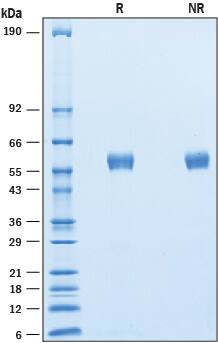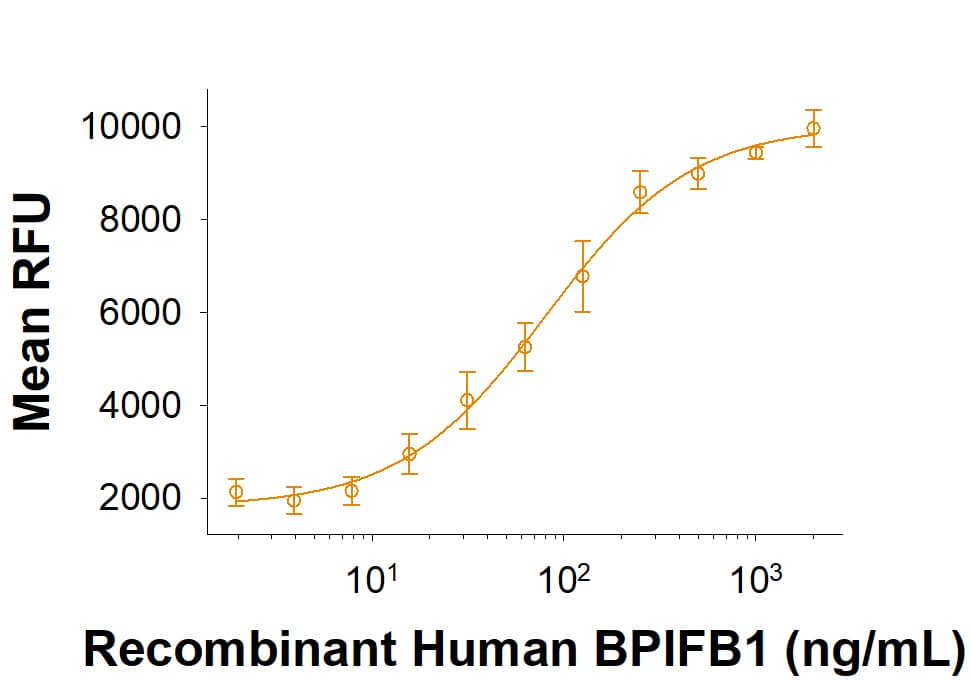Recombinant Human BPIFB1 His-tag Protein, CF
R&D Systems, part of Bio-Techne | Catalog # 10195-BF

Key Product Details
Product Specifications
Source
Human embryonic kidney cell, HEK293-derived human BPIFB1 protein
Thr22-Gln484, with a C-terminal 6-His tag
Thr22-Gln484, with a C-terminal 6-His tag
Purity
>95%, by SDS-PAGE visualized with Silver Staining and quantitative densitometry by Coomassie® Blue Staining.
Endotoxin Level
<0.10 EU per 1 μg of the protein by the LAL method.
N-terminal Sequence Analysis
Thr22
Predicted Molecular Mass
51 kDa
SDS-PAGE
55-61 kDa, under reducing conditions
Activity
Measured by its ability to bind fluorescein-conjugated E. coli Bioparticles.
The ED50 for this effect is 30-240 ng/mL.
The ED50 for this effect is 30-240 ng/mL.
Scientific Data Images for Recombinant Human BPIFB1 His-tag Protein, CF
Recombinant Human BPIFB1 His-tag Protein Binding Activity
Recombinant Human BPIFB1 His-tag binds to fluorescein-conjugatedE. coliBioparticles. The ED50 for this effect is 30-240 ng/mL.Recombinant Human BPIFB1 His-tag Protein SDS-PAGE
2 μg/lane of Recombinant Human BPIFB1 His-tag was resolved with SDS-PAGE under reducing (R) and non-reducing (NR) conditions and visualized by Coomassie® blue staining, showing bands at 55-61 kDa.Formulation, Preparation and Storage
10195-BF
| Formulation | Lyophilized from a 0.2 μm filtered solution in PBS. |
| Reconstitution | Reconstitute at 500 μg/mL in PBS. |
| Shipping | The product is shipped at ambient temperature. Upon receipt, store it immediately at the temperature recommended below. |
| Stability & Storage | Use a manual defrost freezer and avoid repeated freeze-thaw cycles.
|
Background: BPIFB1
References
- Bingle, C. D. and C. J. Craven (2002) Hum. Mol. Genet. 11:937.
- Alves, D. B. et al. (2017) Braz. Oral Res. 31:e6.
- Bingle, L. et al. (2012) Histochem. Cell Biol. 138:749.
- Balakrishnan, A. et al. (2013) Innate Immun. 19:339.
- De Smet, E. G. et al. (2017) Int. J. Chron. Obstruct. Pulmon. Dis. 13:11.
- Saferali, A. et al. (2015) Am. J. Respir. Cell. Mol. Biol. 53:607.
Long Name
BPI Fold Containing Family B Member 1
Alternate Names
C20orf114, LPLUNC1, VEMSGP
Gene Symbol
BPIFB1
UniProt
Additional BPIFB1 Products
Product Documents for Recombinant Human BPIFB1 His-tag Protein, CF
Product Specific Notices for Recombinant Human BPIFB1 His-tag Protein, CF
For research use only
